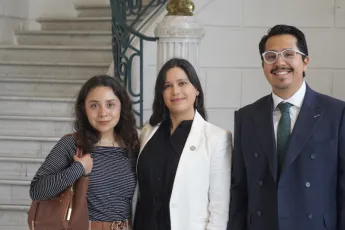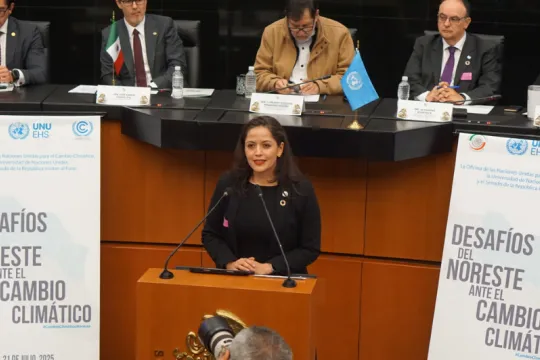
© AJUVES
From 26 to 28 August, the Commission for Environmental Preservation, Climate Change and Ecological Protection of the Mexico City Congress convened the “Environment Parliament 2025”, a three-day event to which the Commission's Chair, Elvia Guadalupe Estrada Barba and Technical Secretary, Ramón Cruz Aquino, invited the United Nations University Institute for Environment and Human Security (UNU-EHS).
The Parliament sought to provide a space for dialogue, learning, dissemination, and exchange of ideas on environmental protection, management, restoration and conservation, climate change mitigation and adaptation, ecological protection, and animal welfare, while also gathering proposals to address Mexico City’s socioenvironmental challenges. The first day included a presentation by the civil society organization Alianza Juvenil por la Sostenibilidad (AJUVES) on Mexico’s environmental agenda, noting both progress and gaps in legislation and enforcement. On the second day, the Mexico City Environment Secretariat (SEDEMA) outlined the city’s strategic environmental priorities, followed by questions from congress members on their local implementation, with particular attention given to the southern and eastern areas of the city.
TUC is currently helping to create spaces where actors from different sectors, including neighbours and residents, explore activities and solutions to address challenges such as frequent heatwaves and urban heat island effects, as seen in the municipality of Naucalpán. Located in the north-western metropolitan area of Mexico City, this Urban Lab seeks to integrate climate adaptation measures while also improving public spaces such as Plaza Revolución.
On 27 August, the second day of the Parliament, Andrea Ramírez Agudelo and Alejandra Ramos Gálvez, researchers at UNU-EHS, conducted a capacity-development session “Environment and Cities: Sustainable Urban Land Restoration”, which introduced participants to the Transformative Urban Coalitions project via a backcasting exercise. This session presented a tool included in the Toolbox: Tools to Weave Urban Futures of Transformative Urban Coalitions, which begins with a clear vision of a desired future and works backwards to identify the actions needed to reach it. Participants engaged in the exercise through five steps:
- Identifying inspiring examples and challenges for Mexico City, drawing on international experiences, nature-based solutions, strategies for enabling urban land restoration and the importance of coherence between frameworks, policies, and implementation. These points were based on lessons from TUC’s urban labs and materials from the Trigger Change! Innovations in Sustainable Urban Land Restoration course, developed with the UNCCD and the G20 Global Land Initiative.
- Selecting a role for diverse coalition building; most participants assumed the roles of “environmental advocates” and “local visionaries,” while fewer chose the role of “deal weavers.”
- Envisioning the future of Mexico City in 2050 by drafting newspaper headlines, many of which highlighted the city’s success as a global leader in water management innovation.
- Prioritizing strategies and decisions that would be transformative, including strengthening water infrastructure and advancing environmental education across all levels in an inclusive way, moving beyond an “expert-only” perspective. Scenarios where challenges persisted or worsened were also discussed.
- Coming back to the present, participants created newspaper headlines set in 2025 to capture how the city’s path toward resilient development begins, with an emphasis on expanding green areas, enhancing public spaces and supporting vulnerable populations.
This TUC-informed exercise, in which approximately 60 congress representatives participated, underscored the importance of dialogues for sharing diverse perspectives, creating opportunities for research to inform public policy processes and supporting the aim of integrating diverse expertise into more transformative decision-making.
The toolbox is the result of intense years of work from all in the TUC Consortium. Its soft launch is expected at COP 30 in Belém, Brazil in 2025. Its aim is to foster inclusive and participatory citymaking by engaging a wide range of actors in shaping climate actions that drive tangible change. It brings together a curated set of approaches and tools, structured around five steps to Weave Urban Futures: (1) building and supporting a locally-based coalition, (2) developing a shared understanding of the local context, (3) creating a shared vision for the future, (4) formulating strategies and implementation mechanisms and (5) learning by doing and learning from doing. The Toolbox is further enriched with experiences and lessons from the five TUC Urban Labs, where the tools were tested, refined and adapted in real-world contexts.
The “Environment Parliament 2025” concluded on 28 August with a plenary session where congress representatives presented different proposals. Beyond its formal closure, the event demonstrated the value of such spaces in shaping more sustainable urban futures, where lessons from initiatives like TUC can inform policy dialogues and be scaled up. It also underscored the importance of inclusive arenas for discussion to bridge decisions across multiple levels of governance while addressing environmental and climate concerns. As highlighted during the Parliament and reflected in the proposals, the city faces pressing water management challenges, yet other issues such as heatwaves should not be overlooked and could be integrated into future measures.
